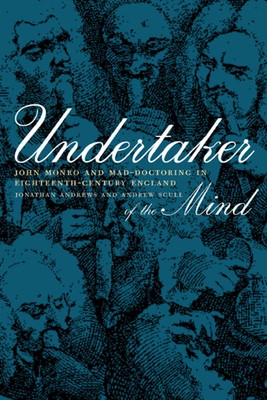
- We will send in 10–14 business days.
- Author: Jonathan Andrews
- Publisher: University of California Press
- ISBN-10: 0520231511
- ISBN-13: 9780520231511
- Format: 16.3 x 23.7 x 3.2 cm, kieti viršeliai
- Language: English
- SAVE -10% with code: EXTRA
Reviews
Description
As visiting physician to Bethlem Hospital, the archetypal "Bedlam" and Britain's first and (for hundreds of years) only public institution for the insane, Dr. John Monro (1715-1791) was a celebrity in his own day. Jonathan Andrews and Andrew Scull call him a "connoisseur of insanity, this high priest of the trade in lunacy." Although the basics of his life and career are well known, this study is the first to explore in depth Monro's colorful and contentious milieu. Mad-doctoring grew into a recognized, if not entirely respectable, profession during the eighteenth century, and besides being affiliated with public hospitals, Monro and other mad-doctors became entrepreneurs and owners of private madhouses and were consulted by the rich and famous.
Monro's close social connections with members of the aristocracy and gentry, as well as with medical professionals, politicians, and divines, guaranteed him a significant place in the social, political, cultural, and intellectual worlds of his time. Andrews and Scull draw on an astonishing array of visual materials and verbal sources that include the diaries, family papers, and correspondence of some of England's wealthiest and best-connected citizens. The book is also distinctive in the coverage it affords to individual case histories of Monro's patients, including such prominent contemporary figures as the Earls Ferrers and Orford, the religious "enthusiast" Alexander Cruden, and the "mad" King George III, as well as his crazy would-be assassin, Margaret Nicholson.
What the authors make clear is that Monro, a serious physician neither reactionary nor enlightened in his methods, was the outright epitome of the mad-trade as it existed then, esteemed in some quarters and ridiculed in others. The fifty illustrations, expertly annotated and integrated with the text, will be a revelation to many readers.
EXTRA 10 % discount with code: EXTRA
The promotion ends in 22d.18:27:53
The discount code is valid when purchasing from 10 €. Discounts do not stack.
- Author: Jonathan Andrews
- Publisher: University of California Press
- ISBN-10: 0520231511
- ISBN-13: 9780520231511
- Format: 16.3 x 23.7 x 3.2 cm, kieti viršeliai
- Language: English English
As visiting physician to Bethlem Hospital, the archetypal "Bedlam" and Britain's first and (for hundreds of years) only public institution for the insane, Dr. John Monro (1715-1791) was a celebrity in his own day. Jonathan Andrews and Andrew Scull call him a "connoisseur of insanity, this high priest of the trade in lunacy." Although the basics of his life and career are well known, this study is the first to explore in depth Monro's colorful and contentious milieu. Mad-doctoring grew into a recognized, if not entirely respectable, profession during the eighteenth century, and besides being affiliated with public hospitals, Monro and other mad-doctors became entrepreneurs and owners of private madhouses and were consulted by the rich and famous.
Monro's close social connections with members of the aristocracy and gentry, as well as with medical professionals, politicians, and divines, guaranteed him a significant place in the social, political, cultural, and intellectual worlds of his time. Andrews and Scull draw on an astonishing array of visual materials and verbal sources that include the diaries, family papers, and correspondence of some of England's wealthiest and best-connected citizens. The book is also distinctive in the coverage it affords to individual case histories of Monro's patients, including such prominent contemporary figures as the Earls Ferrers and Orford, the religious "enthusiast" Alexander Cruden, and the "mad" King George III, as well as his crazy would-be assassin, Margaret Nicholson.
What the authors make clear is that Monro, a serious physician neither reactionary nor enlightened in his methods, was the outright epitome of the mad-trade as it existed then, esteemed in some quarters and ridiculed in others. The fifty illustrations, expertly annotated and integrated with the text, will be a revelation to many readers.


Reviews